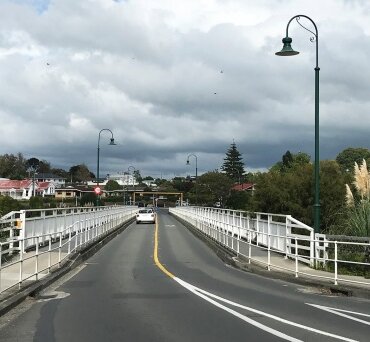
Crossing the bridge

Waipā District Council will progress a third bridge business case in 2022, despite the outcome of a regional transportation model indicating Cambridge’s two bridges will cope with projected traffic capacity in the longer term.
The results of the Waikato Regional Transportation Model (WRTM), which models predicted transport trends and network use for the district’s future traffic needs, were discussed at a Council’s Strategic Planning & Policy Committee workshop on Tuesday.
Read what Crs Roger Gordon and Philip Coles say about the third bridge.
The workshop and modelling results were presented by Council’s Strategy Planner, Rachel Algar, Manager – Transportation, Bryan Hudson and Principal Policy Advisor, David Totman. The workshop demonstrated the work underway to inform Council’s Transport Strategy, which is currently under review.
The WRTM showed good traffic flow even at peak times for most routes in both Cambridge and Te Awamutu up to 2051.
“Modelling the network as at 2051 indicates most of the network shows a level of service as level A, or green, which is good. Some of the main routes show a slightly lower level of service. The worst level of service is shown around the Hautapu Interchange which is a level of service E to F at peak times.”
It is common to to use an A to F system of assessing traffic flow – or ‘levels of service’ – for the roading network, with A being no delays, and F being a complete stand-still. The model indicated that during peak traffic periods, between 4pm and 6pm on weekdays, the worst rating received in the Cambridge CBD was C or D for 2051 population projections. However it was acknowledged that at some locations and intersections, where peaks in travel are more pronounced, longer delays would occur.
Further afield in Te Awamutu, most traffic routes were green, or level A, with some streets experiencing a higher level of congestion in 2051 than currently being experienced. Heaviest traffic flows and some delays would continue to occur around the intersections with State Highway 3.
Councillors had a robust discussion about the validity of the modelling due to outdated population projections used from 2013. Council staff advised that all modelling has a margin of error and this was taken into account as well as the latest housing and employment projections in the two towns being used in the model.
Principal Policy Advisor, David Totman said latest information indicated population growth was already starting to slow down, as would be expected while New Zealand’s international border remained closed.
“We run population projections every three to five years after census data is available, and we’re expecting the next projections in 2023. We know we’re currently facing the pressures of growth but it is expected to slow due to the lack of international migration,” Totman said.
“The projections we have are the best estimate we have from the demographers who regularly do this work.”
The model also showed that Cambridge’s two bridges, Victoria Bridge and Fergusson Bridge, which cross the Waikato River, would cope with the projected traffic flows to 2051 and did not highlight a need for additional capacity.
Despite this, staff conclusions based on the modelling have indicated that a new bridge would be needed in the longer term, even if this was driven by the need to retire the historic Victoria bridge from vehicle traffic use, and that Council would start on a business case in 2022-23 for this purpose. Council has included provision for a third bridge in its 2021-51 Infrastructure Strategy. Provision for a third bridge was also included in the Council’s previous Infrastructure Strategy.
Three key pieces of work would be needed to inform the business case; being Council’s Transport Strategy, the Hamilton-Waikato Metro Spatial Plan business case recommendations and the Waipā Community Spatial Plan, due to be completed in 2022.
In the meantime, Council will continue to monitor the historic Victoria Bridge, built in 1907, and undertake improvements and maintenance with a major repaint planned for 2022-23.
For media enquiries, contact: Karen Cousins, 027 300 5232








